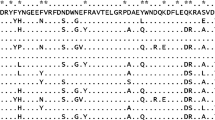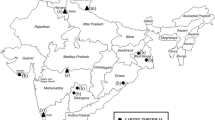Abstract
The DQB1 locus is located in the major histocompatibility complex (MHC) class II region and involved in immune response. We identified 20 polymorphic sites in a 228 bp fragment of exon 2, one of the most critical regions of the MHC DQB1 gene, in 60 Nigerian goats. Four sites are located in the peptide binding region, and 10 amino acid substitutions are peculiar to Nigerian goats, compared with published sequences. A significantly higher ratio of nonsynonymous/synonymous substitutions (d N/d S) suggests that allelic sequence evolution is driven by balancing selection (P < 0.01). In silico functional analysis using PANTHER predicted that substitution P56R, with a subPSEC score of −4.00629 (Pdeleterious = 0.73229), is harmful to protein function. The phylogenetic tree from consensus sequences placed the two northern breeds closer to each other than either was to the southern goats. This first report of sequence diversity at the DQB1 locus for any African goat breed may be useful in the search for disease-resistant genotypes.





Similar content being viewed by others
References
Adebambo AO, Adebambo O, Williams JL, Blott S, Urquart B (2011) Genetic distance between two popular Nigerian goat breeds used for milk production. Livest Res Rural Dev 23(2) article 26. http://www.lrrd.org/lrrd23/2/adeb23026.htm. Accessed 28 Dec 2012
Ajmone-Marsan P (2010) The Globaldiv Consortium: a global view of livestock biodiversity and conservation. Anim Genet 41(Suppl. 1):1–5
Amills M, Sulas C, Sanchez A, Bertoni G, Zanoni R, Obexer-Ruff G (2004) Structural characterization of the caprine major histocompatibility complex class II DQB1 (Cahi-DQB1) gene. Mol Immunol 41:843–846
Ballingall KT, Rocchi MS, McKeever DJ, Wright F (2010) Trans-species polymorphism and selection in the MHC Class II DRA genes of domestic sheep. PLoS One 5:e11402
Belov K (2011) The role of the major histocompatibility complex in the spread of contagious cancers. Mamm Genome 22:83–90
Bergstrom T, Gyllensten U (1995) Evolution of the MHC class II polymorphism: the rise and fall of class II gene function in primates. Immunol Rev 143:14–31
Brunham LR, Singaraja RR, Pape TD, Kejariwal A, Thomas PD, Hayden MR (2005) Accurate prediction of the functional significance of single nucleotide polymorphisms and mutations in the ABCA1 gene. PLoS Genet 1:e83
Call MJ (2011) Small molecule modulators of MHC class II antigen presentation: mechanistic insights and implications for therapeutic application. Mol Immunol 48:1735–1743
Ettinger RA, Liu AW, Nepom GT, Kwok WW (2000) β57-Asp plays an essential role in the unique SDS stability of HLA-DQA1*0102/DQB1*0602 αβ protein dimer, the class II MHC allele associated with protection from insulin-dependent diabetes mellitus. J Immunol 165:3232–3238
Felsenstein J (1985) Confidence limits on phylogenies: an approach using the bootstrap. Evolution 39:783–791
Hedrick PW, Kim TJ (2000) Genetics of complex polymorphisms: parasites and the maintenance of the major histocompatibility complex variation. In: Singh RS, Krinbas CB (eds) Evolutionary genetics: from molecules to morphology. Cambridge University Press, Cambridge, pp 204–234
Hughes AL, Nei M (1989) Nucleotide substitution at major histocompatibility complex class II loci: evidence for overdominant selection. Proc Natl Acad Sci USA 86:958–962
Hughes AL, Hughes MK, Howell CY, Nei M (1994) Natural selection at the class II major histocompatibility complex loci of mammals. Philos Trans R Soc Lond B Biol Sci 346:359–366
Ibeagha-Awemu EM, Kgwatalala P, Ibeagha AE, Zhao X (2008) A critical analysis of disease-associated DNA polymorphisms in the genes of cattle, goat, sheep and pig. Mamm Genome 19:226–245
Kennedy LJ, Randall DA, Knobel D, Brown JJ, Fooks AR, Argaw K, Shiferaw F, Ollier WER, Sillero-Zubiri C, Macdonald DW, Laurenson MK (2010) Major histocompatibility complex diversity in the endangered Ethiopian wolf (Canis simensis). Tissue Antigens 77:118–125
Larkin MA, Blackshields G, Brown NP, Chenna R, McGettigan PA, McWilliam H, Valentin F, Wallace IM, Wilm A, Lopez R, Thompson JD, Gibson TJ, Higgins DG (2007) Clustal W and Clustal X version 2.0. Bioinformatics 23(21):2947–2948
Marini NJ, Thomas PD, Rine J (2010) The use of orthologous sequences to predict the impact of amino acid substitutions on protein function. PLoS Genet 6:e1000968
Muema EK, Wakhungu JW, Hanotte O, Jianlin H (2009) Genetic diversity and relationship of indigenous goats of sub-Saharan Africa using microsatellite DNA markers. Livest Res Rural Dev 21(2) article 28. Retrieved 28 Dec 2012
Muixi L, Gay M, Munoz-Torres PM, Guitart C, Cedano J, Abian J, Alvarez I, Jaraquemada D (2011) The peptide-binding motif of HLA-DR8 shares important structural features with other type 1 diabetes-associated alleles. Genes Immun 12:504–512
Nei M, Gojobori T (1986) Simple methods for estimating the numbers of synonymous and nonsynonymous nucleotide substitutions. Mol Biol Evol 3(5):418–426
Nepom BS, Nepom GT, Coleman M, Kwok WW (1996) Critical contribution of β chain residue 57 in peptide binding ability of both HLA-DR and HLA-DQ molecules. Proc Natl Acad Sci USA 93:7202–7206
Nowak J, Mika-Witkowska R, Mendek-Czajkowska E, Rogatko-Koros M, Graczyk-Pol E, Pyl E, Klimczak A, Wojcik M, Prochorec-Sobieszek M, Maryniak R, Zupanska B (2011) The patterns of MHC association in aplastic and non-aplastic paroxysmal nocturnal hemoglobinuria. Arch Immunol Ther Exp 59:231–238
Okpeku M, Ozoje MO, Adebambo OA, Agaviezor BO, O’Neill MJ, Imumorin IG (2011a) Preliminary analysis of microsatellite-based genetic diversity of goats in southern Nigeria. Anim Genet Res 49:33–41
Okpeku M, Yakubu A, Peters SO, Ozoje MO, Ikeobi CON, Adebambo OA, Imumorin IG (2011b) Application of multivariate principal component analysis to morphological traits of goats in southern Nigeria. Acta Agric Slovenica 98(2):101–109
Pariset L, Cureti A, Ligda C, Ajmorne-Marsan P, Valentini A (2009) Econogene Consortium: geographical patterning of sixteen goat breeds from Italy, Albania and Greece assessed by single nucleotide polymorphisms. BMC Ecol 9:20
Paterson S, Wilson K, Pemberton JM (1998) Major histocompatibility complex variation associated with juvenile survival and parasite resistance in a large unmanaged ungulate population (Ovis aries L.). Proc Natl Acad Sci USA 95:3714–3719
Petsalaki E, Stark A, Garcıa-Urdiales E, Russell RB (2009) Accurate prediction of peptide binding sites on protein surfaces. PLoS Comput Biol 5:e1000335
Piertney SB, Oliver MK (2006) The evolutionary ecology of the major histocompatibility complex. Heredity 96:7–21
Radwan J, Biedrzycka A, Babik W (2010) Does reduced MHC diversity decrease viability of vertebrate populations? Biol Conserv 143:537–544
Reche PA, Reinherz EL (2003) Sequence variability analysis of human class I and class II MHC molecules: functional and structural correlates of amino acid polymorphisms. J Mol Biol 331:623–641
Salles PA, Santos SC, Rondina D, Weller M (2011) Genetic variability of six indigenous goat breeds using major histocompatibility complex-associated microsatellite markers. J Vet Sci 12:127–132
Schwaiger FW, Maddox J, Ballingall K, Buitkamp J, Crawford AM, Dutia BM, Epplen JT, Ferguson ED, Groth D, Hopkins J, Rhind SM, Sargan D, Wetherall J, Wright H (1996) The ovine major histocompatibilty complex. In: Schook LB, Lamont SJ (eds) The major histocompatibility complex region of domestic animal species. CRC, Boca Raton, pp 121–176
Sena L, Schneider MPC, Brenig BB, Honeycutt RL, Honeycutt DA, Womack JE, Skow LC (2011) Polymorphism and gene organization of water buffalo MHC-DQB genes show homology to the BoLA DQB region. Anim Genet 42:378–385
Stear MJ, Innocent GT, Buitkamp J (2005) The evolution and maintenance of polymorphism in the major histocompatibility complex. Vet Immunol Immunopathol 108:53–57
Takahashi K, Nei M (2000) Efficiencies of fast algorithms of phylogenetic inference under the criteria of maximum parsimony, minimum evolution, and maximum likelihood when a large number of sequences are used. Mol Biol Evol 17:1251–1258
Takeshima S, Chen S, Miki M, Kado M, Aida Y (2008) Distribution and origin of bovine major histocompatibility complex class II DQA1 genes in Japan. Tissue Antigens 72:195–205
Tamura K, Peterson D, Peterson N, Stecher G, Nei M, Kumar S (2011) Mega5: molecular evolutionary genetics analysis using maximum likelihood, evolutionary distance, and maximum parsimony methods. Mol Biol Evol 28:2731–2739
Thomas PD, Campbell MJ, Kejariwal A, Mi H, Karlak B, Daverman R, Diemer K, Muruganujan A, Narechania A (2003) Panther: a library of protein families and subfamilies indexed by function. Genome Res 13(9):2129–2141
Toll-Riera M, Laurie S, Alba MM (2011) Lineage-specific variation in intensity of natural selection in mammals. Mol Biol Evol 28:383–398
Yakubu A (2009) Fixing collinearity instability in the estimation of body weight from morphobio-metrical traits of West African Dwarf goats. Trakia J Sci 7:61–66
Yakubu A, Salako AE, Imumorin IG (2010a) Multivariate analysis of spatial patterns of morphological traits in West African Dwarf goats in three agro-ecological zones of Nigeria. J Appl Anim Res 38:257–260
Yakubu A, Salako AE, Imumorin IG, Ige AO, Akinyemi MO (2010b) Discriminant analysis of morphometric differentiation in West African Dwarf and Red Sokoto goats. South Afr J Anim Sci 40(4):381–387
Yakubu A, Salako AE, Imumorin IG (2011) Comparative multivariate analysis of biometric traits of West African Dwarf and Red Sokoto goats. Trop Anim Hlth Prod 43(3):561–566
Yeager M, Hughes AL (1999) Evolution of the mammalian MHC: natural selection, recombination, and convergent evolution. Immunol Rev 167:45–58
Zhang J, Nielsen R, Yang Z (2005) Evaluation of an improved branch-site likelihood method for detecting positive selection at the molecular level. Mol Biol Evol 22:2472–2479
Zhao Y, Xu H, Shi L, Zhang J (2011) Polymorphisms in exon 2 of MHC Class II DRB3 gene of 10 domestic goats in Southwest China. Asian-Australas J Anim Sci 24:752–756
Acknowledgments
The authors are grateful to the College of Agriculture and Life Sciences and Mario Einaudi Center for International Studies of Cornell University, Ithaca, New York, for financial support. Many thanks to the Nigerian Government Tertiary Educational Trust Fund fellowship awarded through Nasarawa State University to AY. Approval of research visits by AY, MIT, MAA, and BOA to Cornell University by Prof. W. Ron Butler is gratefully acknowledged.
Author information
Authors and Affiliations
Corresponding author
Rights and permissions
About this article
Cite this article
Yakubu, A., Salako, A.E., De Donato, M. et al. Genetic Diversity in Exon 2 of the Major Histocompatibility Complex Class II DQB1 Locus in Nigerian Goats. Biochem Genet 51, 954–966 (2013). https://doi.org/10.1007/s10528-013-9620-y
Received:
Accepted:
Published:
Issue Date:
DOI: https://doi.org/10.1007/s10528-013-9620-y




